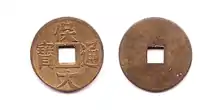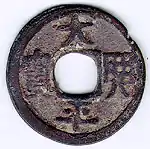Bảo Đại Thông Bảo
The Bảo Đại Thông Bảo (Hán tự: 保大通寶) was a round Copper-alloy coin with a square hole produced by the Nguyễn dynasty under French protection and was the last cash coin produced both in Vietnam and the world, this ended a long series of cast Vietnamese coinage that started with the Thái Bình Hưng Bảo in 970.[2] The cast Bảo Đại Thông Bảo were produced at the Thanh Hóa Mint, while the machine-struck variants were produced in Hanoi by the colonial French government.[3] These coins bear the name of Emperor Bảo Đại who ascended the throne in 1926 but continued the production of the earlier Khải Định Thông Bảo (啓定通寶) that bore his father's name until 1933 when he ordered the production of new coins with his reign name, which was normal as previous Vietnamese emperors also kept producing cash coins with the inscription of their predecessors for a period of time. The cast smaller Bảo Đại Thông Bảo cash coins with blank reverses were only valued at 1⁄600 piastre.[4]
| Value | 1 văn, 10 văn (French Indochinese piastre) |
|---|---|
| Mass | machine-struck 1.40 g, cast, 1 văn 3.31 g, cast, 10 văn 4.01 g |
| Composition | Copper (Brass) |
| Years of minting | 1933–1940 |
| Circulation | 1933–1948 |
| Obverse | |
_-_Art-Hanoi_05.jpg.webp) | |
| Design | 保大通寶 (Bảo Đại Thông Bảo) |
| Reverse | |
_-_Art-Hanoi_04.jpg.webp) | |
| Design | Blank 1 văn |
_-_Art-Hanoi_06.jpg.webp) | |
| Design | 十文 (thập văn)[1] 10 văn |
The Bảo Đại Thông Bảo were probably cast into 1941 or 1942 and the production was stopped because the occupying Japanese forces wanted the copper and were acquiring all of the cash coins they could find and stockpiling them in Haiphong for shipment to Japan for the production of war materials.[5]
Cash coins would continue to circulate officially in the Democratic Republic of Vietnam until 1948 with an official exchange rate set of 20 cash coins for 1 đồng.[5]
Machine-struck Bảo Đại Thông Bảo coins

The French simultaneously began minting brass machine-struck cash coins in Hanoi, with the same inscription as the cast Bảo Đại Thông Bảo cash coins, with production officially starting in June 1933.[6][7] These machine-struck cash coins weighed 1.36 grams and had an official exchange rate of 1⁄600 piastre, but were probably only valued at 1⁄1000 piastre.[5]
These coins were minted at the Hanoi Mint because the French had cut the funding for producing cast cash coins at the Thanh Hòa Mint which meant that the Protectorate of Annam wasn't producing enough cast cash coins to satisfy the demands of the Vietnamese markets for these low value coins for every day exchange.[5] The machine-struck Bảo Đại Thông Bảo cash coins were designed by René Mercier.[8]
The French authorities purely produced these coins for market liquidity and the French colonial authorities did not accept these coins for any payment to the government such as taxes or levies.[6]
There were two variants of this cash coins where one had a large version of the Chinese "大" (Đại) while the other had a smaller "大".[5] After the Japanese had forced the production of Bảo Đại Thông Bảo coins because they were commandeering all copper in Vietnam new sapèque-like coins made from zinc were created in Hanoi and by the Japan Mint in Osaka to replace these coins as the copper was being used for the production of Japanese weaponry and other military equipment, though the coins from Osaka didn't make it to the Vietnamese market as the shipping of war supplies was deemed more important by the Japanese government.[5]
There were a total of 98,000,000 machine-struck Bảo Đại Thông Bảo sapèques produced.[9]
References
- 保大 Bảo Đại 1926-1945 cash coins By Sema (Art-Hanoi) Cash coins of Bao Dai were the last cash-style coins produced in the world. Retrieved: 04 March 2018
- Dr. R. Allan Barker. (2004) The historical Cash Coins of Viet Nam. ISBN 981-05-2300-9
- François Thierry de Crussol (蒂埃里) (14 September 2015). "Sapèques frappées de Bảo Đại 保大 - Struck cash coins of Bảo Đại - Bảo Đại thông bảo 保大通寳, «monnaie courante de [l'ère] Bảo Đại». Cuivre, Ø 18,3, 1,39 g. - La frappe des Bảo Đại thông bảo 保大通寳" (in French). TransAsiart. Retrieved 24 April 2020.
- François Thierry de Crussol (蒂埃里) (14 September 2015). "Sapèques de Bảo Đại 保大 - Cash coins of Bảo Đại" (in French). TransAsiart. Retrieved 24 April 2020.
- "Sapeque and Sapeque-Like Coins in Cochinchina and Indochina (交趾支那和印度支那穿孔錢幣)". Howard A. Daniel III (The Journal of East Asian Numismatics – Second issue). 20 April 2016. Retrieved 4 March 2018.
- BELAUBRE Jean, "Un technicien méconnu du monnayage : René Mercier et la sapèque Bảo Đại, 1933". Bulletin de la Société Française de Numismatique, avril 1980, n°4, pp. 685-687. (in French).
- ĐẶNG Ngọc Oanh, "Les distinctions honorifiques annamites", Bulletin des Amis du Vieux Huê, 1915-IV, pp. 391-406. (in French).
- Howard A. Daniel, III 2018, p. 97.
- French Southeast Asia Coins & Currency by Howard A. Daniel III (page 97).
Sources
- Howard A. Daniel, III (3rd edition, 2018) The Catalog and Guidebook of Southeast Asian Coins and Currency. Volume I: France. ISBN 0-931960-01-0


_-_Art-Hanoi_01.jpg.webp)
_Art-Hanoi_02.jpg.webp)
_02.jpg.webp)